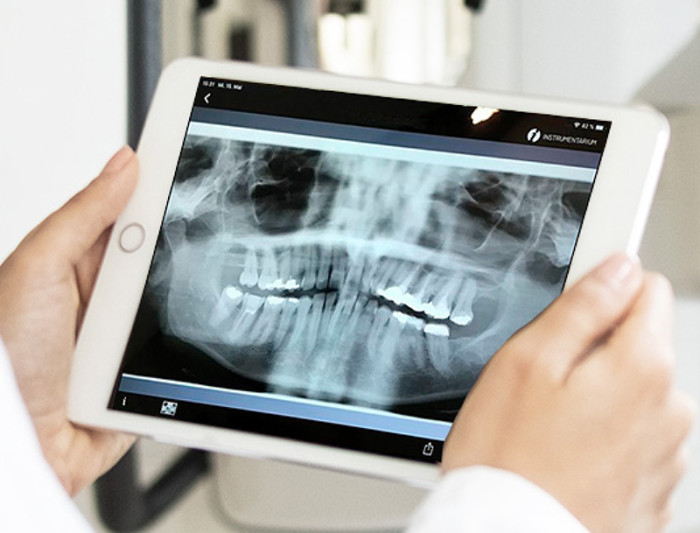Periodontitis, periodontal disease – bacterial inflammation of the gums around the teeth
Periodontal disease, also sometimes called periodontitis, is bacterial inflammation in the oral cavity. It usually onsets on the gums, around the teeth, and spreads from there to the jawbone. Periodontitis often goes unnoticed for a long time. Since inflamed gums do not cause severe symptoms straight away, an estimated 50% of all citizens suffer from periodontal disease. At first, periodontal disease is associated with inflammation of the gums, also known as gingivitis, but if this inflammation escalates further into the bones, this can lead not only to severe pain due to tissue and bone degradation, but also to tooth loss. But how can you prevent periodontitis? What are the causes, and how can we treat it if the inflammation has progressed? The following article provides you with all the important information about periodontal disease.

Causes of periodontal disease
There can be a variety of reasons for periodontitis, but it generally occurs due to a weakened immune system and poor oral hygiene. The weaker the immune system, the less well it can defend itself against bacteria, and this also applies in the oral cavity. If a weakened immune system meets with poor oral hygiene, bacteria can multiply more easily and thus cause inflammation in the periodontium. The causes of the weakened immune system can be either physical or emotional, which is why it is often the case that the exact cause of periodontal disease is not able to be determined. In general, however, it is possible to say that good oral hygiene can prevent periodontal disease in many cases.
Course and symptoms of periodontitis
As already mentioned, periodontitis usually results from inflammation of the gums, which often manifests as bleeding gums when brushing your teeth. Periodontal disease spreads from the gums, until you get so-called gingival pockets. Gingival pockets are gaps between the gums and the tooth in which bacteria can collect and multiply even more easily. As time progresses, the bacteria penetrate further to the tooth root and jawbone, where they destroy the structures supporting the teeth and thus lead to tooth loss.
The symptoms of periodontitis vary depending on the stage of the disease. Early symptoms of periodontal disease include frequent bleeding gums and bad breath. As the disease progresses, periodontitis can mainly be identified by the gingival pockets, exposed tooth necks, and regression of the gums. If you still do not respond, you will develop severe pain in the teeth and also become tired and listless due to your immune system being severely weakened.
Is periodontitis painful?
Periodontal disease can be very painful, especially in the later stages, when the inflammation has penetrated far into the gums. At this point, action should be taken quickly to prevent tooth loss. The weakening of the immune system can also lead to further inflammation in the body, or even to a high fever, which, in turn, causes severe pain. If you experience pain in the region of the teeth or the jaw, you should definitely contact your dentist and have yourself examined.
Identifying periodontal disease correctly
As mentioned previously, there are special symptoms that enable you to identify each stage of periodontal disease. As a rough guide, if you get bleeding gums after brushing your teeth for a prolonged period of time, or if you regularly have bad breath despite adequate oral hygiene, you should contact your dentist. If you notice any of the additional symptoms, such as gingival pockets or even exposed teeth, you should contact your dentist immediately.

How do you treat periodontal disease?
First of all, the periodontal disease is determined using a probe, which measures the depth of the pocket around your teeth and quickly shows your doctor whether they should suspect periodontal disease. In addition, your blood index can be determined, which shows your doctor whether you have major inflammation in your body, allowing the dentist to confirm the diagnosis. Once periodontal disease is diagnosed, treatment can begin. During the treatment, the dentist will first try to thoroughly clean your teeth and gingival pockets in order to eliminate the bacteria. However, if the bacteria are too deep or already at the root, a minor surgical intervention will be needed. Here, the dentist will remove part of your gums in order to have a better view and more surface of the tooth to work with, and will then remove all the bacteria.
If the necks of the teeth are exposed after the treatment, or have already been caused by periodontitis, this must also be treated by the dentist. To do so, the dentist will remove healthy tissue from another location and use this to rehabilitate the tissue removed from the neck of the tooth.
Cost of periodontal treatment
The cost of periodontal treatment is around 80 to 150 pounds, depending on the severity of the periodontitis and the prices charged by the dentist or periodontist. Health insurance will not fully cover this treatment, and so you will have to bear part of the cost of periodontal disease yourself. On average, health insurance providers will pay between 30 and 40 pounds for periodontal treatment.
Remedies for periodontal disease
There are several different ways to treat periodontal disease, depending on the severity of the disease. The periodontal remedy Emdogain can be used for slight bacterial attacks. It promotes regeneration of your bones and teeth and can thus be a very effective remedy in mild cases. Once this has been applied to the root of your tooth, it will help regenerate the cementum, the fibres and the jawbone, and can thus reverse the damage caused by periodontal disease.
If the periodontitis is more advanced, one will usually opt for laser treatment, to both relieve your pain, on the one hand, and eliminate any inflammation, on the other. This method is considered to be comparatively gentle and can even be used in conjunction with scaling and root planing for advanced periodontal disease.
In many cases, however, a combination of the two above methods will be used to treat periodontal disease optimally. Purely naturopathic treatments are strongly discouraged, as are homeopathic remedies or natural treatments, because, in such cases, the inflammation needs to be fought strongly and quickly, so as to not encourage another outbreak of periodontal disease.
Is there such a thing as chronic periodontal disease?
Yes. Periodontitis is roughly divided into chronic and aggressive periodontitis. Chronic periodontitis is a relapsing disease that is usually mild. With appropriate prophylaxis and regular tooth cleaning at the dentist, severe forms of chronic periodontosis can be prevented.
When it comes to aggressive periodontal disease, this usually takes a very rapid and pronounced course, resulting in the inflammation attacking the tooth and jawbone very quickly. Studies show that this type of periodontal disease is not associated with an increased bacterial load, as has long been assumed, but is rather more genetically determined. Most often, aggressive periodontal disease onsets during adolescence (during puberty).
Clear braces (aligners) for periodontal disease?
In principle, nothing stands in the way of treating misaligned teeth with aligners, even if you have periodontal disease. You just have to pay attention to good, regular cleaning of you teeth and the aligners so as not to support the inflammation.
Properly preventing periodontal disease – prophylaxis for inflamed gums
To prevent periodontal disease the right way, you just have to follow a few rules:
Brush your teeth regularly; this will remove all food residues and prevent acid from forming.
Use dental floss to thoroughly clean the interdental spaces.
Do not brush your teeth too hard (no pressure, use circular movements)
Brush your tongue regularly, ideally with a tongue scraper
Smokers must pay particular attention to optimal oral hygiene, as they have a 5–6 times higher risk of periodontal disease.